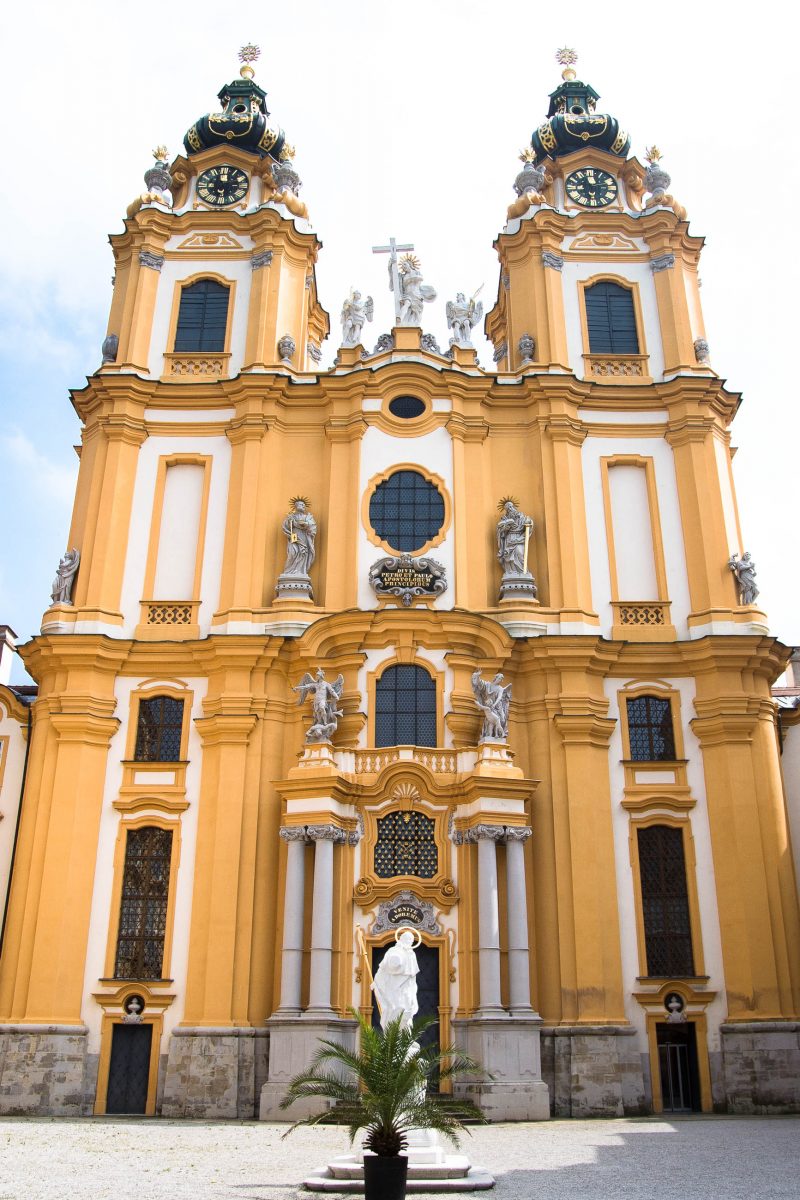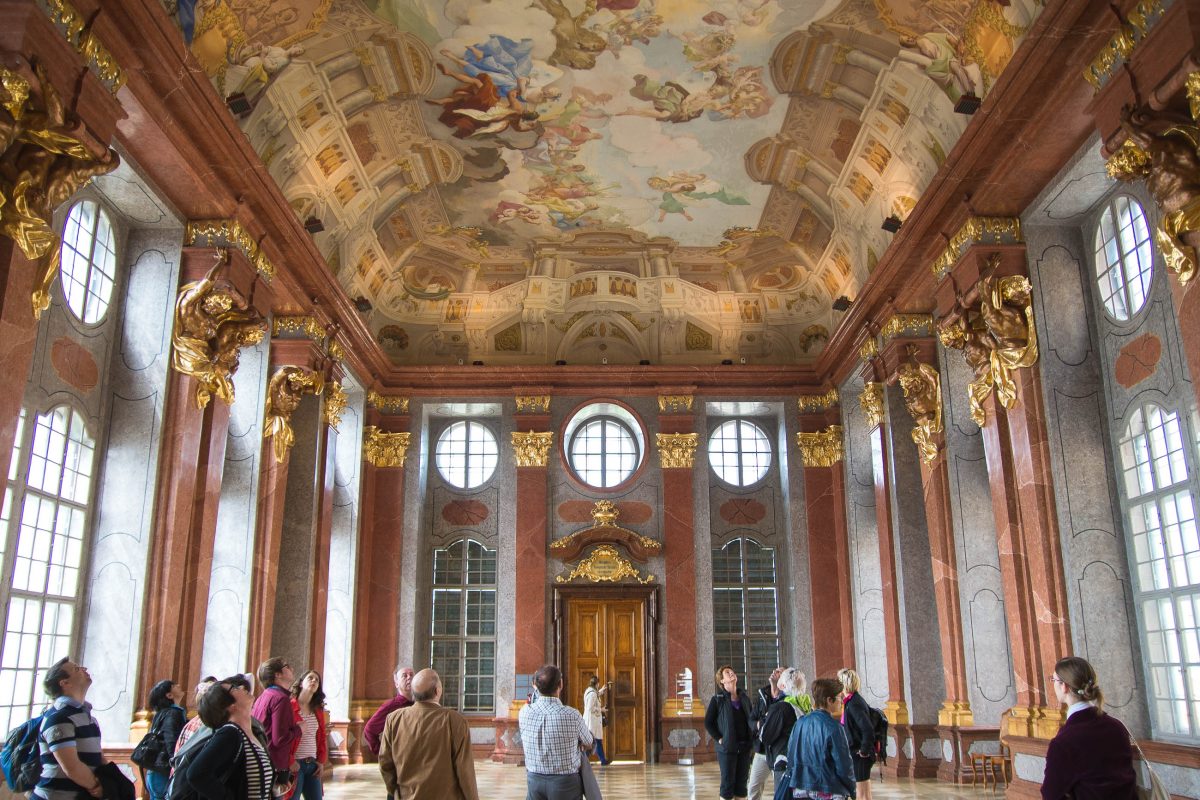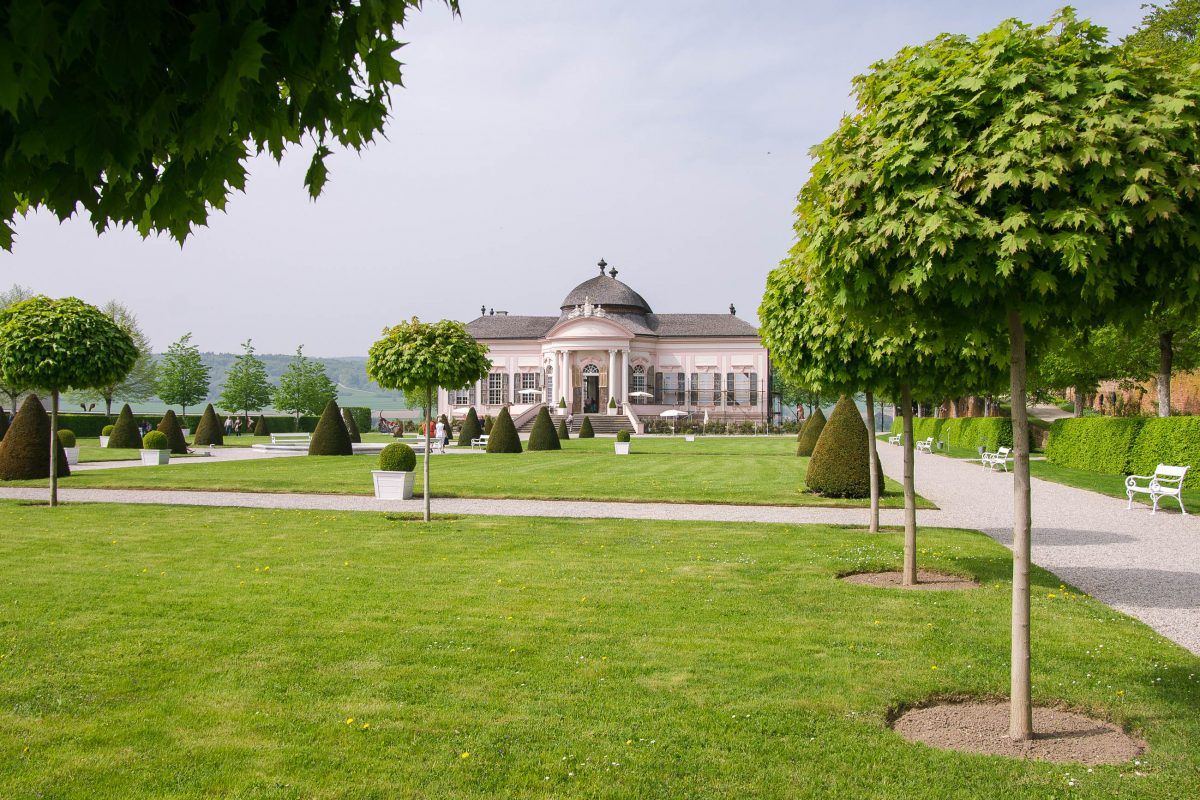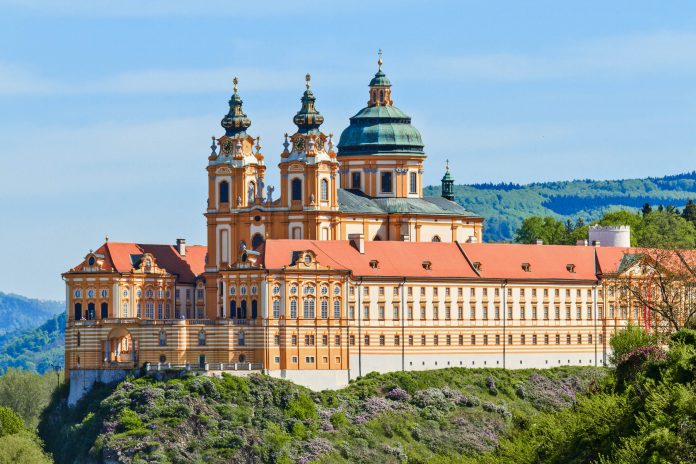Das Stift Melk am niederösterreichischen Ufer der Donau ist das Wahrzeichen der Stadt Melk und die größte barocke Klosteranlage Österreichs. Neben der prachtvollen Stiftskirche gibt es eine Vielzahl an weiteren herrlich ausgestatteten Räumen zu entdecken.
Wie eine goldene Krone thront das prächtige Stift Melk im gleichnamigen Ort in der niederösterreichischen Wachau über der Donau. Mit seiner herrlichen Architektur, seinem prächtigen Interieur und Reichtum an kunsthistorischen Schätzen zählt es zu den wichtigsten Barockbauten in Österreich und in ganz Europa. Seit dem Jahr 2000 gehört das Stift Melk zum Weltkulturerbe der UNESCO und ist inmitten der Wachau auf der Liste unserer Top 10 Sehenswürdigkeiten von Österreich und unserer 10 sehenswertesten Klöster der Welt vertreten.
BILDER: Stift Melk
Stift Melk wurde im Jahr 1089 als Babenberger-Burg und später als Benediktiner-Kloster gegründet und war seither auch nie von einem anderen Orden bewohnt. Sein heutiges Erscheinungsbild stammt aus dem frühen 18. Jahrhundert, als das Kloster nach Plänen des berühmten Barock-Architekten Jakob Prandtauer neu errichtet wurde. Der gewaltige Bau misst an seiner Längsachse 320 Meter, nur der Südflügel, in dem sich der opulente Marmorsaal befindet, ist bereits 240 Meter lang.
Sehenswürdigkeiten im Stift Melk
Die Benediktiner hatten über 900 Jahre Zeit, Wissen und Erfahrung anzuhäufen, und aus dem Stift ein Zentrum von Kunst, Kultur, Glaube und Wissenschaft werden zu lassen. Dieses Wissen wird bis heute an die über 900 Schülerinnen und Schüler des Stiftsgymnasiums weitergegeben und auch die tausende Besucher aus aller Welt, die durch die prunkvollen Räumlichkeiten des Melker Stiftes flanieren, profitieren davon.
Tipp: Die gesamte Pracht des Stiftes mit seinen Legenden und Geschichten kann am besten im Zuge einer geführten Tour erlebt werden. Bei einem Besuch das Stiftes sollte man außerdem keineswegs nur geradeaus schauen, sondern die herrlichen Fresken an Decke und Wände auf sich wirken lassen.

Stiftskirche
Die Kirche St. Petrus und Paulus ist das Herzstück von Stift Melk und zählt zu den schönsten Barockkirchen Österreichs.
Mit einer 64m hohen Kuppel beeindruckt sie durch ihr mit Stuck, Marmor und Blattgold nahezu monströs geschmücktes Inneres.
Die Kirche liegt am Prälatenhof, der in der Mitte vom Kolomanibrunnen geziert wird, der einst dem aufgelösten Stift Waldhausen gehörte.
Der Innenhof ist trapezförmig angelegt und auf die Kirche mit der majestätischen Kuppel ausgerichtet.
Kaiserstiege und Kaisergang mit Stiftsmuseum
Vom südwestlichen Ende des Prälatenhofes führt ein Eingang zur opulenten Kaiserstiege, die in den ehemaligen Gemächer der Kaiserfamilie führt und überschwänglich mit Malereien, Stuck und Skulpturen geschmückt ist. Sie mündet in den Kaisergang, der heute noch von Gemälden der ehemaligen Herrscher aus den Häusern Babenberg und Habsburg gesäumt wird.
In den ehemaligen kaiserlichen Gemächern auf der anderen Seite des Ganges ist heute das Stiftsmuseum untergebracht, welches den Besucher in modern inszenierten Ausstellungen durch die bauliche, wirtschaftliche und kulturelle Geschichte von Stift Melk von der Gründung bis heute führt. Neben einem sehenswerten Modell des gesamten Bauwerks sind hier Exponate aus der Schatzkammer und dem Archiv und besonders wertvolle Stücke aus der Bibliothek ausgestellt.
Marmorsaal
Der opulente Marmorsaal im Stift Melk liegt im Südflügel und schließt direkt an den Kaisertrakt an. In den mit Stuck und Marmor prachtvoll verzierten Prunksaal wurden früher weltliche Gäste zu Feierlichkeiten und Banketts geladen.

An seiner Decke beeindruckt das traumhafte Fresko von Paul Troger, das mit Pallas Athene, der griechischen Göttin der Weisheit und dem gewaltigen Herkules das Herrscherhaus der Habsburger verkörpern soll. Der Marmorsaal führt direkt auf eine großzügige Terrasse, die den Westtrakt des Stiftsgebäudes abschließt und einen traumhaften Blick über die Stadt Melk und die Donauufer bietet. Hier befindet sich auch der Eingang zur Stiftsbibliothek.
Tipp: Nicht nur wegen des Deckenfreskos lohnt sich im Marmorsaal ein Blick nach oben! In der Mitte stehend wirken alle gemalten Säulen, die die Decke „tragen“ gerade. Betrachtet man sie von einem der Eingänge in de Saal, sieht man erst, dass sie eigentlich schief sind.
Bibliothek
In der Bibliothek des Stiftes Melk verschlägt es nicht nur eingefleischten Bücherwürmern die Sprache. Ob der unglaublichen Anzahl an wertvollen, teilweisen uralten Bänden, wird auch der Laie von Ehrfurcht gepackt. Einige der 100.000 literarischen Werke in der Melker Stiftsbibliothek zählen zu den wertvollsten schriftlichen Erbstücken aus dem Mittelalter. Und auch hier lohnt sich ein Blick zur Decke auf das prachtvolle Deckenfresko Paul Trogers, diesmal eine Allegorie des Glaubens.
Stiftspark
Den krönenden Abschluss eines Besuchs des Stiftes Melk bildet ein gemütlicher Spaziergang durch den lauschigen Stiftspark. Kurz nach dem Eingang fällt bereits der barocke Gartenpavillon von Franz Munggenast ins Auge.

Er wurde Mitte des 18. Jahrhunderts erbaut und mit von Johann Wenzel Bergi mit kunstvollen exotischen Fresken geschmückt, die heute das Café im Pavillon zieren und als Kulisse für Konzerte und andere Veranstaltungen dienen. Durch den herrlichen Garten führen von farbenfrohen Blüten gesäumte Wege durch Rosenbeete bis zu einem Trinkwasser-Becken, welches von 250 Jahre alten Linden gesäumt wird.
Tipp: Naschkatzen sollten es sich nicht entgehen lassen, ein Stück der berühmten Kolomani-Torte zu genießen, die nach dem Schutzpatron von Melk benannt wurde und als Komposition aus Schokolade und Holundermarmelade den Gaumen verwöhnt.
Weiterführende Links:
Offizielle Website von Stift Melk mit Öffnungszeiten und Eintrittspreisen
Offizielle Website des Stiftsrestaurants in Melk mit Öffnungszeiten





